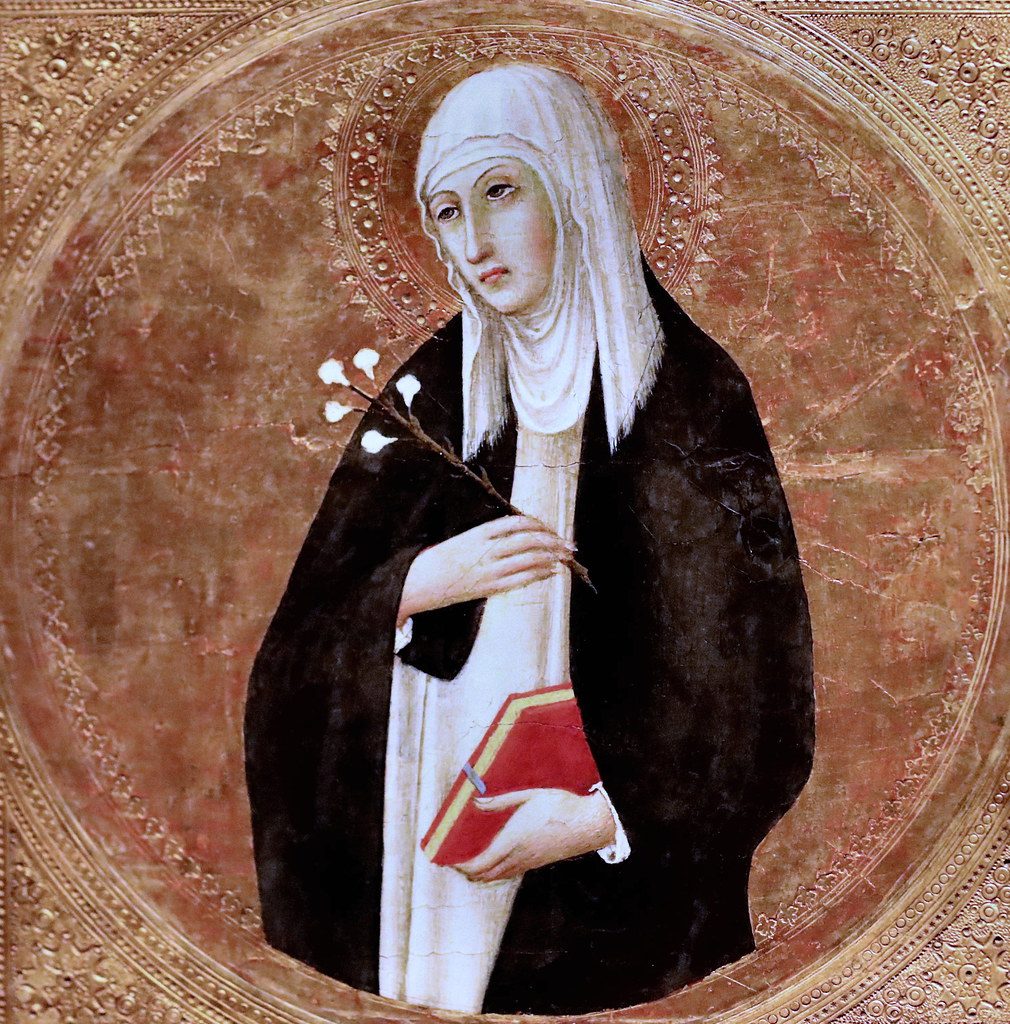
This is a guest post by Dr. Kathy Lilla Cox, Research Associate in the Department of Theology and Religious Studies at the University of San Diego. Dr. Lilla Cox’s research bridges fundamental moral theology, human cognition studies, and social ethics. Topics include neuroethics, malformation in conscience formation, and the resources of monastic spiritual traditions for contemporary believers, among other exciting topics. Dr. Lilla Cox is a member of the Catholic Theological Society of America, the Society of Christian Ethics, and after the June 2021 meeting will become a Board member of the College Theology Society.
Memorial of St. Catherine of Siena, Doctor of the Church[1]
Women as Leaders and Models of Faithful Witness
Today we celebrate Catherine of Siena: a woman who broke boundaries, who refused to be constrained by social standards and restrictions on women, while focusing on God’s love as the foundation for her life and work.[2] Given her feast, I read today’s scriptures looking for and pondering the women in the text. What do we learn about women during this fourth week of Easter – a season where old patterns are challenged, being replaced, a time of reconceiving our expectations of how and in whom Jesus the Christ appears?
The section from Acts describes Paul in the Antioch synagogue delivering a message that Jesus is the Messiah. However, in Paul’s brief historical recitation placing Jesus in the Davidic lineage, this line stopped me: “After that he gave them judges until the time of the prophet Samuel (Acts 13:20).” It was in graduate school that I learned that the judges in ancient Israel, included women like Judith and Deborah. Women deemed wise, authoritative, learned enough to make decisions for their communities. Women who served in leadership roles.
Meanwhile, the reading from John’s gospel returns us to the last supper. We pick up where we left off on Holy Thursday where Jesus has just finished washing the feet of the disciples (men and women). I found myself reflecting on Jesus’ statement: “Amen, amen, I say to you, whoever receives the one I send receives me, and whoever receives me receives the one who sent me (Jn 13:20).” In those first weeks after the crucifixion and Resurrection with their world chaotic, upended and changing the disciples failed miserably in recognizing who Jesus sent to them.
After all the first witnesses to the resurrection were women, an unexpected development. Peter doubted Mary Magdala; Thomas doubted the disciples in the upper room, the Sanhedrin doubted Peter and Paul. People eventually got that Jesus was resurrected – believing first the women, then those who returned from Emmaus, and Thomas his fellow disciples. As we have been hearing in Acts, others began to believe those whom Jesus sent receiving them and their good news. If we have doubt about new life and resurrection amidst an ongoing pandemic, violence, upheaval, and change we are in good company.
If we are the messengers of good news within this time of doubt, then like the women judges, disciples, and witnesses to the resurrection we must trust our own authority. They trusted their own judgement, sense of God, and the decisions that sprang from that place. In Catherine of Siena, we find that she had successes and failures. Her counsel was sought after and ignored. She was a complex woman with many talents and gifts. Catherine found ways to live authoritatively the calling from God she believed she had. She provides a model for us along with women in scripture and through the ages how to claim our authority as witnesses to Jesus’s good news. My hope is that as Church we more fully recognize the unexpected people Jesus sends to us in our chaotic times, in our brokenness, and in our grief. And in recognizing Jesus’ messengers that we receive them with wonderment and awe, as they illuminate our glorious beauty.
Postscript: My heart sank, and I groaned when I pulled up
today’s readings on the USCCB’s website for this memorial feast day of St.
Catherine of Siena, Doctor of the Church.
Why does the USCCB (or whoever does their liturgical calendar) continue
to include the status of virgin for the women?
What does virginity have to do with Catherine’s faithfulness and witness
to her call, her political activism, her preaching, and letter writing? A quick
perusal of some male Doctors of the church indicates that their ecclesiastical
position bears mentioning – priests, bishops, and abbots, but not their sexual status
for example, as married or virgin. The
contrast of virgin for the women is especially striking when we consider
Augustine. Augustine, who had a child
with a woman he lived with but did not marry, is not named as an unwed father, but
Bishop and Doctor of the Church.
Meanwhile, Hildegard of Bingen’s role as Abbess is overlooked, while
Bernard of Clairvaux is recognized as Abbot.
When will we retire the double standard that straight men’s sexual
histories can be unnamed in favor of their positions in the church and their
faithful witness, while for women and LBTGQAI+ members their status as virgins
or celibates all too often takes precedence over their service in the church
and their faithful witness?
[1] Only four women are named Doctor of the Church: Catherine of Siena, Therese of Lisieux, Teresa of Avila, and Hildegard of Bingen.
[2] See Mary Catherine Hilkert, OP,’s wonderful book about Catherine of Siena and how she can inspire us today, Speaking with Authority: Catherine of Siena and the Voices of Women Today.



